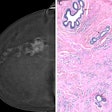Reactions to the results of the Canadian National Breast Screening Study-2 have ranged from strongly dismissive to cautiously accepting. But everyone in the debate -- including the authors -- agree on one thing: Older women should not interpret the information as a green light to skip out on preventive breast healthcare.
"On the contrary, our findings may encourage women who are currently avoiding breast screening, because they do not want a mammogram, [to seek out a physical exam]," said author Dr. Cornelia Baines, deputy director of the Canadian National Breast Screening Study (CNBSS), and a professor in the department of public health sciences at the University of Toronto.
"Often older women will say ‘I had a mammogram once and I will never have one again.’ The older women who are getting no breast screening at all may now say, ‘I can reduce my risk of breast cancer by getting a good clinical exam,’" she said.
A good clinical exam may be enough for women aged 50 to 59, according to CNBSS-2 results that were published in the Sept. 20 issue of the Journal of the National Cancer Institute. The study, led by Dr. Anthony Miller, director of the CNBSS, examined the mortality benefits of mammograms for older women and found that imaging did not substantially reduce breast cancer death rates.
The study seemed to fly in the face of conventional wisdom: that because of breast screening, cancer rates have taken a fairly dramatic downturn.
"For the first time in 40 years, and for the past several years in a row as reported by the National Cancer Institute, breast cancer death rates have declined, in large part due to the increased use of screening mammography," according to a statement issued by the American College of Radiology in response to the study.
But the CNBSS authors went a step further by calculating how much mammography contributes to the reduction.
"We are not discounting the value of screening mammograms compared to no screening at all, but we are saying that regular breast physical examinations with breast self-examination are an alternative to annual mammograms," Baines said.
Canadian National Breast Screening Study-2
The trial randomly assigned 39,405 women aged 50 to 59 years, recruited between January 1980 and March 1985, to one of two study arms: mammography plus a physical exam or physical exam only. All participants were taught breast self-examination (BSE).
Two-view film-screen mammography was used for craniocaudal and mediolateral views until 1985, and craniocaudal and mediolateral oblique views were used thereafter. Physical exam included visual inspection and palpation and lasted about 10 minutes, the authors explained. Follow-up occurred through the Canadian National Cancer Registry and the National Mortality Database (JNCI, Sept. 20, 2000, Vol.92:18, pp. 1490-1499).
According to the results, 267 invasive breast cancers were detected in the mammography-plus-physical-exam group, while 148 were found in the physical-exam-only group.
"The total number of deaths were similar in the mammography-plus-physical-examination and physical-examination-only groups, 734 and 690, respectively," they wrote. "There were 88 deaths from breast cancer in the mammography-plus-physical-examination group and 90 deaths in the physical-examination-only group."
In addition, survival rate at 10 years for women with those cancers detected by physical exam only stood at 89.9%, compared to 75% for the mammography-and-exam group.
"Although it could have been anticipated that, if mammography makes the major contribution to the benefit of combined screening, we would have observed it after 7 years’ follow-up, we have now conducted sufficient additional follow-up to be able to conclude that it does not do so," they wrote in their conclusion. "Our findings…suggest another option for screening women over age 50 years: annual physical examination and the teaching of BSE by skilled health professionals."
Next page: The randomization question
Click here to discuss this story.


















